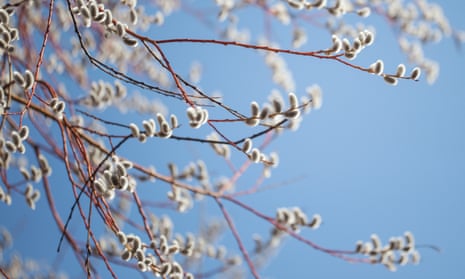When I was a kid growing up in Singapore, it seemed like Christmas was barely over when preparations for Chinese New Year would start.
It was one of my favourite times of year, not for the feasting and fireworks, but mainly because of the horticultural extravaganza that would ensue. Garden centres literally double in size with plants symbolic of new beginnings, as pots of auspicious citrus trees, bright red celosia and tubs of rice plants laden with sheaves of grain filled their car parks and road verges.
Forced spring bulbs and branches of plum blossom would be displayed on every surface of my grandparents’ house, kept fresh with the air-conditioning whacked up high. But my favourite of all was branches of pussy willow that after a week or two of sitting as silvery, fuzzy perfection would eventually explode into leafy growth.
Although I don’t really celebrate Chinese New Year after living in the UK for 20 years, the one thing I still do is bring in willow branches. Just as in the sweltering heat of Singapore, cut branches set in a vase of water indoors in the UK will soon burst into life, months earlier than they would do outdoors, giving you a little piece of spring at the darkest time of year.
But this isn’t a temporary ornament, like a vase of flowers, because if treated right the branches will work like cuttings, sprouting roots and turning into plants that can eventually be transferred outdoors. A nifty way of getting new plants for free and cheating the seasons for those hungry for the new growth of spring.
Years of experimentation with a bunch of other common garden species has shown me this same vase of water treatment will work for a range of other easy-to-root species. The bright red stems of Cornus alba ‘Sibirica’ and the acid yellow of the closely related C sericea ‘Bud’s Yellow’ make great candidates for this technique.
For those that like flowers, the famously easy to propagate hydrangeas will work too, as will the hardy fuchsias like Fuchsia magellanica in my experience. Even the evergreen herbs will respond surprisingly well to this, with rosemary, thyme and sage very accommodating to being bunged in a glass of water.
To increase your chances of success, here are the only three things you need to do. First, plants need light, even as cut material in a vase. So put them as close to a light as possible. Ideally, within a couple of metres of a bright, south-facing window.
Secondly, replace the water and wash out the vase at least once a week, being careful not to damage any nascent roots.
Finally, popping in half a 300mg soluble aspirin tablet (a compound based on a plant growth regulator) per litre of water as an optional extra, can keep the water clear and improve the success of the cuttings’ roots at the same time.
Email James at james.wong@observer.co.uk or follow him on Twitter@Botanygeek

Comments (…)
Sign in or create your Guardian account to join the discussion